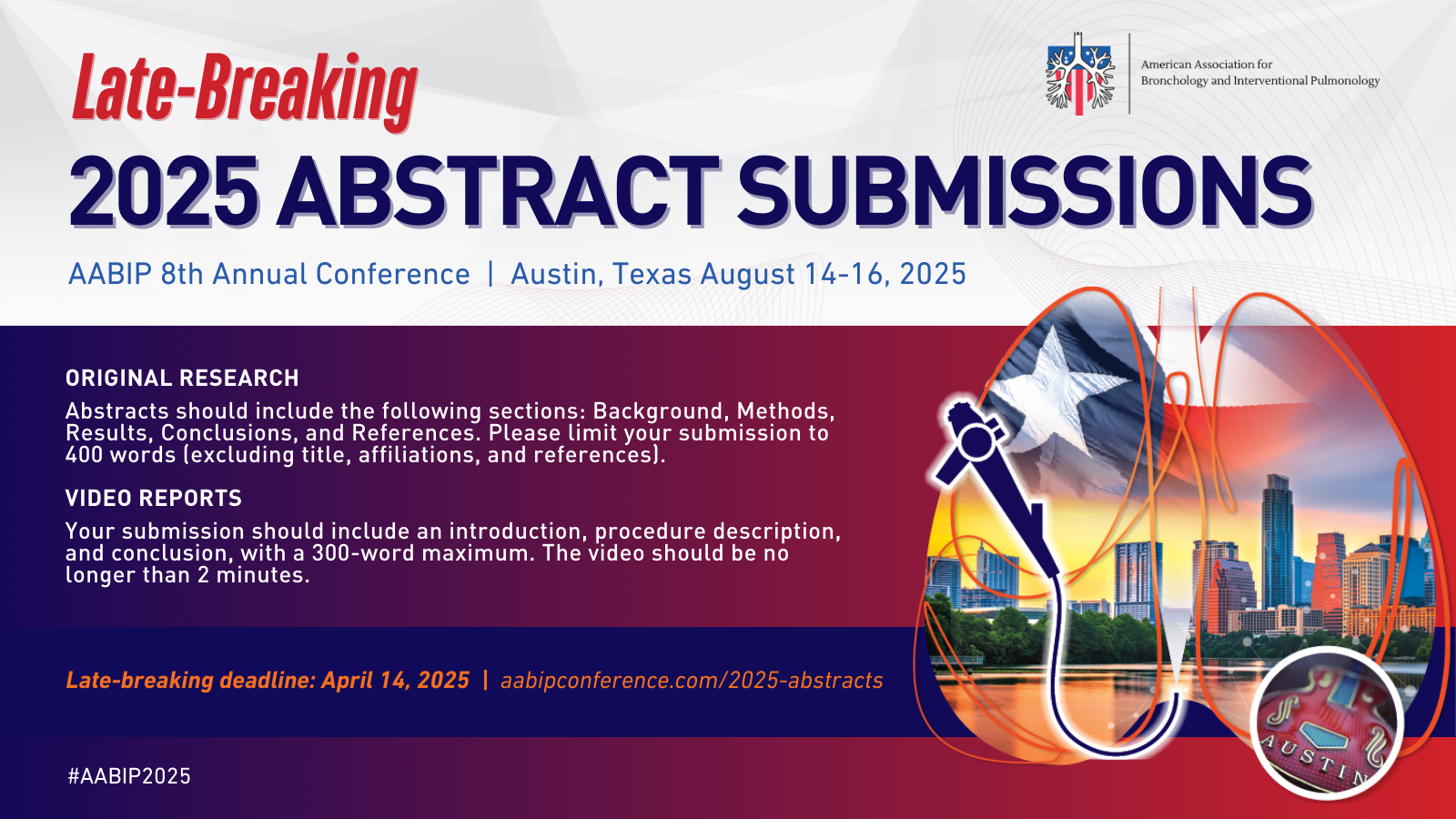AABIP Advocacy StatementAmerican Association for Bronchology and Interventional Pulmonology
Statement on Fundamental Principles and Safety of Bronchoscopic Electrocautery and Argon Plasma Coagulation (PDF Version) December 15, 2023 Thermal ablative therapies such as electrocautery (EC) and argon plasma coagulation (APC) are forms of electrosurgery and mainstays of therapeutic bronchoscopy. These are commonly performed procedures by interventional bronchoscopists. In the AquiRE Bronchoscopy Registry, 21.3% of cases used some EC (contact electrosurgery), and 35.2% used some APC (non-contact electrosurgery) (1). To clarify terminology, electrosurgery, also known as "surgical diathermy" or electrocautery, refers to the application of heat, produced by high-frequency electrical current to cut, coagulate, or fulgurate tissue. Electrocautery, APC, and various lasers are commonly used to re-establish airway patency or control bleeding(2). These tools can be used via a rigid or flexible bronchoscope. Using tools through a flexible bronchoscope affords a broader implementation in the bronchoscopy community and improves the ability to reach areas that are challenging for a rigid bronchoscope, such as lobar and segmental disease. In July 2023, Olympus Corporation of America (Olympus © [Center Valley, PA, U.S.A.] announced a voluntary field corrective action to address concerns using laser or APC via some of their bronchoscopes(3). Specifically, the press release addressed complaints of endobronchial combustion that occurred with the use of laser-compatible bronchoscopes. Olympus© has received three complaints of endobronchial combustion during laser or APC procedures, one of which resulted in the death of a patient(4). The press release stated that Olympus laser-compatible bronchoscopes are only compatible with Nd:YAG or 810 nm diode laser(3). Due to the critical nature of the press release and the considerable number of AABIP members who use these technologies regularly, this document was created to serve as a concise refresher of equipment needed, principles, and general guidelines for using EC and APC within the airways. Both EC and APC are classified as thermal ablative modalities. There are a few essential components for these modalities: a high-frequency electrical generator, an insulated probe to transfer energy to target tissue (monopolar or bipolar), a neutral pad (neutral electrode) to complete the circuit (if the monopolar probe is used), an insulated instrument to prevent electrical current leaking, and if APC is used, argon gas with a microelectrode catheter which transports the gas and an electrical current simultaneously(5). With either tool, it is essential to ensure that both the FiO2 and FeO2 are equal to or below 0.40 if conventional closed-circuit ventilation is used and ventilation is held if jet ventilation is used. Proper communication with the supporting staff and anesthesia colleagues is essential to ensure that FiO2 and FeO2 are below 0.4 and that the patient can tolerate low FiO2 during electrosurgery or laser application. If that cannot be assured, the clinical team should consider alternatives to thermal ablation such as mechanical debulking and cryotherapy. Additional measures to prevent endobronchial fires include maintaining an adequate distance between the distal end of the endotracheal tube and the lesion(6). Before activation, the probe's tip must also be at a safe distance from the bronchoscope's tip. The tip of the tool should also be kept at a safe distance from the lesion if a non-contact technique is used: laser (1-10 mm, depending on the laser type and desired power density) or APC (3-5 mm). Both EC and APC produce immediate effects but have distinct advantages and limitations. The basis of EC is the alternating high-frequency electrical current that passes through a probe, which generates heat at the cellular level. The probe can come in various models: blunt-tipped, forceps, wire snare, and knife. The direct application of heat leads to protein denaturation, coagulation, vaporization and direct cell death. The penetration depth is variable depending on selected waveform or setting, the type of probe used and its application time and pressure. Argon plasma coagulation is a non-contact method of electrosurgery. With activation, the positively charged ionized gas flows out of the probe to the closest negatively charged surface. A tungsten wire delivers a high-voltage current, which ionizes the argon gas. With APC, tissue burn is more uniform and superficial at 2-3 mm depth penetration. The delivered heat denatures proteins and evaporates water, which destroys tissues and coagulates blood. The argon gas is inert and acts as a conductor of the high-frequency monopolar current. Risks for both devices, other than airway fires discussed above, include airway perforation and bleeding. Unique APC risks include intracardiac and cerebral gas embolism(7). Gas entry into the bronchial veins can lead to a left-sided gas embolism, and entry into the systemic venous system can lead to a right-sided embolism. Factors that favor embolization include higher flow rates of argon gas, closer proximity of the probe to the target tissue, a high degree of vessel exposure, and application within a confined space (such as segmental airways when the bronchoscope is wedged). Direct tissue contact with the APC probe is the highest risk factor for potentiating gas entry into the intravascular space(8). It is recommended that the gas flow be set to the lowest setting to prevent gas embolism. With over 17,000 units of Olympus© bronchoscopes in the United States affected by the recent statement, bronchoscopists performing therapeutic bronchoscopy with EC or APC are encouraged to review or study the physics and safety principles of electrosurgery and heed the recommendations listed herein to maximize safety (Table 1)(4). The same tenets of safety apply to single-use bronchoscopes. In these regards, educational programs developed by industry, national professional societies or medical centers should incorporate didactic and simulation sessions highlighting the basic physics and safety principles of electrosurgery and laser use in the airways. Table 1. Recommendations for Safe Use of Thermal Ablative Tools Via Flexible Bronchoscopy
This statement was drafted by Drs. Sameer Avasarala, MD (Case Western Reserve University School of Medicine) and Atul C. Mehta, M.D (Respiratory Institute, Cleveland Clinic) and reviewed and approved by the AABIP Board of Directors on 12-1-2023. References 1. Ost DE, Ernst A, Grosu HB, Lei X, Diaz-Mendoza J, Slade M, et al. Therapeutic bronchoscopy for malignant central airway obstruction: success rates and impact on dyspnea and quality of life. Chest. 2015;147(5):1282-98.2. Mahajan AK, Ibrahim O, Perez R, Oberg CL, Majid A, Folch E. Electrosurgical and Laser Therapy Tools for the Treatment of Malignant Central Airway Obstructions. Chest. 2020;157(2):446-53. 3. America OCot. Olympus Issues Voluntary Labeling Update for Bronchoscopes Used with Laser Therapy Equipment 2023 [Available from: https://www.olympus-global.com/news/2023/nr02535.html. 4. Class 1 Device Recall Olympus EVIS EXERA II: United States Food and Drug Administration; 2023 [Available from: https://www.accessdata.fda.gov/scripts/cdrh/cfdocs/cfres/res.cfm?id=200495#:~:text=There%20have%20been%20complaints%20of,laser%20procedures%20with%20the%20bronchoscope.&text=An%20%22URGENT%20MEDICAL%20DEVICE%20CORRECTIVE,23%20was%20sent%20to%20customers. 5. Bolliger CT, Mathur PN, Beamis JF, Becker HD, Cavaliere S, Colt H, et al. ERS/ATS statement on interventional pulmonology. European Respiratory Society/American Thoracic Society. The European respiratory journal. 2002;19(2):356-73. 6. Khemasuwan D, Mehta AC, Wang KP. Past, present, and future of endobronchial laser photoresection. Journal of thoracic disease. 2015;7(Suppl 4):S380-8. 7. Tan AC, Schellekens PP, Wahab P, Mulder CJ. Pneumatosis intestinalis, retroperitonealis and thoracalis after argon plasma coagulation. European Journal of Gastroenterology & Hepatology. 1997;9(12):A78-A9. 8. Folch EE, Oberg CL, Mehta AC, Majid A, Keyes C, Fernandez-Bussy S. Argon Plasma Coagulation: Elucidation of the Mechanism of Gas Embolism. Respiration; international review of thoracic diseases. 2021:1-5. Updated 12/15/2023 |




